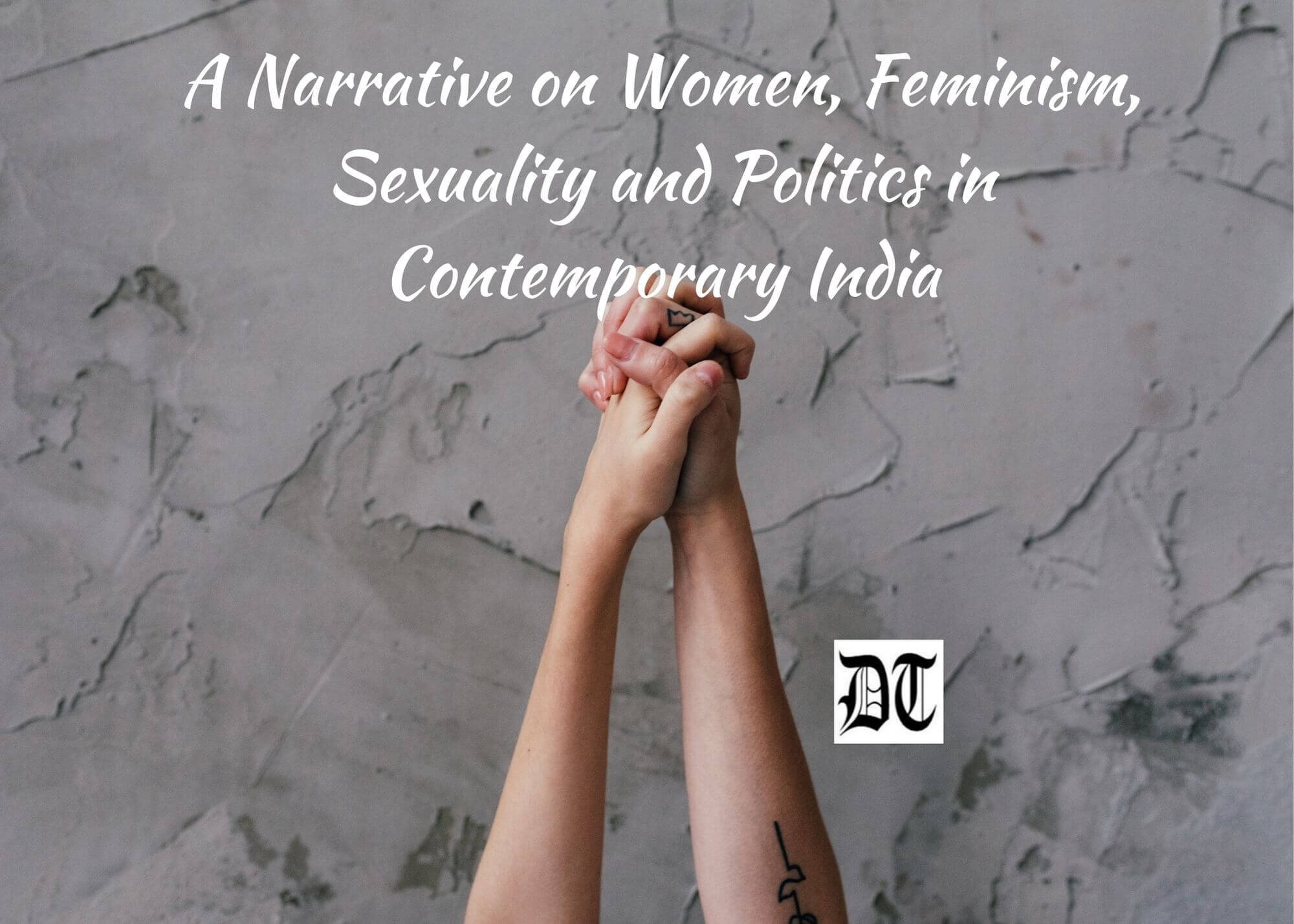Sonia Gandhi’s unperturbed state in her husband’s funeral is acceptable to the urban and sophisticated Indians as Sonia Gandhi is cloning a ‘male’ behavior and thus striving to achieve a ‘superior’ mode of self-expression whereas Sasikala’s slaps on hard stone platform during the funeral of Jayalalithaa situate her as an untutored and hysterical woman. Both these two cases reinforce the misogynistic ideological divide between a man’s capacity for self-control and a woman’s chaotic nature often stratified in patriarchal discourse on politics and power. There are different strands of feminist thought in which any destabilisation of the category of ‘woman’ is often viewed as a threat to the foundation of feminist politics. Konkona Sen Sharma assumes that CBFC has just refused to certify Lipstick Under My Burkha because unlike most Indian films, it deals with ‘female fantasies’.5 And the director of the movie, Alankrita Shrivastava, has also made no secret of her indignation: ‘Maybe they feel that… women should forever be subjected to the representation of the male gaze with no right to tell their stories.’ Here’s an erudite write-up on feminism in contemporary India, by Chirantan, as special feature on International Women’s Day (IWD), exclusively in Different Truths.

For a Sufi master like Bullhe Shah (1680-1758) there is no such thing as duality1 or discrimination. In Tantric principles too, the unification of male and female refers to the indivisible nature of ultimate reality. But, in our daily lives, we love to discriminate in the space of heterosexual encounters. We prefer to live our lives based on the policy of gender discrimination. And when we discriminate we sideline the women as other. It has been observed that even in the corporate space there are so many men, who say that they don’t like to take orders from women.
Power, as it is practiced and maneuvered in today’s India is still a predominantly male domain and the women are often found to internalise and perpetuate the patriarchal categories of thought. Sonia Gandhi’s unperturbed state in her husband’s funeral is acceptable to the urban and sophisticated Indians as Sonia Gandhi is cloning a ‘male’ behavior and thus striving to achieve a ‘superior’ mode of self-expression whereas Sasikala’s slaps on hard stone platform during the funeral of Jayalalithaa situate her as an untutored and hysterical woman. Both these two cases reinforce the misogynistic ideological divide between a man’s capacity for self-control and a woman’s chaotic nature often stratified in patriarchal discourse on politics and power. There are different strands of feminist thought in which any destabilisation of the category of ‘woman’ is often viewed as a threat to the foundation of feminist politics.
The feminist counter-response to the male hegemony across the globe validates the idea of female subjectivity for advancing the interest of women as a ‘group with a unique collective interest’. It’s a strange situation. On the one hand, we are surrounded with images of flamboyantly sexual women in the visual media and images of sexually objectified women in pornographic discourses, and on the other hand, the right-wing political forces construct counteractive nationalist imagery projecting the Indian women as essentially desexualised, mute and docile beings. Both these two strategies are evidently patriarchal.
What needs to be stressed in this context is that women should have control on their own bodies. They need to feel free while expressing their desires. The fear of stigmatisation, however, often silences their voice, no matter whether they belong to economically marginalised sections of the society or the middle-class families. The social regulation of women is not only materialised in terms of overtly coercive practices but also through the process of normalisation. Whereas in Indian villages deviant women are still being categorised as witches, so that they can be safely burnt to death, many upper-class Indian women are interested in operating merely as consumers of commodities and services in a neo-colonial, globalised market-space that is also deeply patriarchal.
Patriarchy is not a descriptive proposition with universal applicability. That is why feminists now find themselves in a situation where they have to negotiate the specific hegemonic masculinities functioning in particular cultural, institutional and economic configurations. Women who want to remain unmarried, women who want to reject the construct of compulsory heterosexuality, women who are not fertile, are not permitted to be socially visible beings. Reduced to their reproductive value, the women fail to have access to their bodies and sexuality. But when they try to resist this, they also feel the need to recognize male domination within specific Indian societies instead of considering it as an unmediated and ‘universal’ force.
Though Mohandas Karamchand Gandhi allowed women to operate in the public space during the anti-colonial struggle, he went to the length of supporting pre-emptive annihilation when the Sikh and Hindu women were committing suicides to save their honour during the communal riots. It ironically stimulates us to remember the women’s protest against Roop Kanwar’s immolation in 1987. There were so many anti-sati marches in Delhi and groups like Sabala Mahila Sangh organised street plays against widow immolation. Though the campaign around sati revealed the strength of the opposition to feminism, the feminist and associated movements learned a lot from that process as huge numbers of rural women joined demonstrations in Rajasthan against the killing of Roop Kanwar.
Some Marxist and Gandhian activists associated with the movements for women’s rights in India feel that the overemphasis on ‘the personal as political’ has to some extent forced people to withdraw their attention from other sorts of mass movements for women’s empowerment. It would be fruitful to keep in mind that women’s movements since the political independence in our country have evolved in numerous ways.
Though Chipko movement was initiated by men, women gradually transformed it into their struggle for a safe environment. In Garhwal, Kumaon and in many other places of the country women have been able to manufacture effective anti-alcohol movements as alcoholism in men resulted in waste of family’s earnings and wife-beating. In the seventies and eighties, their agitation against liquor in Uttarakhand acquired such intensity that the government was forced to declare prohibition in certain areas.
The women gas victims gave rise to a significant movement against the Bhopal disaster of 1984. The late seventies saw the emergence of the new feminist groups who learned to struggle against acts of sexual violence committed by the police and landlords. Parents of dowry victims began to join women’s organisations, who were demonstrating against dowry deaths in Delhi and elsewhere in the late eighties and early nineties. Shahada was a movement against the unjust practices of local landlords in Maharashtra, which was marked by the militant role of the women who raised slogans and mobilised the mass.
It is only recently that feminists in India started talking about hetero or homoerotic desire. Earlier, they were mainly concerned with issues of social, cultural and legal oppressions of women. What creates a dilemma for the Indian youth is that exposed to the worldwide television channels and especially the internet, they are the major consumers of the cultural expressions of sexual liberalism but they are still in many ways located within the traditional familial boundaries. Thus, sexual conservatism continues to function in deeply deceptive and ambiguous ways. Unfortunately enough, liberalism with regard to sexuality is mostly male oriented and the patriarchal cultural practices, while effecting the socialisation of girls, reinforce the ideology of ‘shame’ and ‘honour’ in relation to female sexuality.
A study on youth sexuality suggests that even the discourse of sexual liberalism put forward by cultural globalisation have been found ‘inadequate’ to displace this patriarchal ideology of control.3 The use of modern technology and family planning have certainly helped the women to come out of the drudgery of household. Yet a survey made on 500 Bengali middle-class working women of Calcutta reveals that the young women who are exposed to different streams of learning and many of whom have professional careers, are ‘more conservative and non-scientific in their attitudes than their elders’.4
Konkona Sen Sharma assumes that CBFC has just refused to certify Lipstick Under My Burkha because unlike most Indian films, it deals with ‘female fantasies’.5 And the director of the movie, Alankrita Shrivastava, has also made no secret of her indignation: ‘Maybe they feel that… women should forever be subjected to the representation of the male gaze with no right to tell their stories’6.
It often happens in cases of sexual molestation that the society starts troubling its head about the moral status of the female victims. A woman is considered responsible for whatever is being done to her because she is always supposed to be in a position to provoke the sexual desire of a male observer. This politics of condemning the victim becomes once again evident in the responses of the politicians when Bengaluru witnessed the mass molestation of women on the eve of New Year 31st December, 2016, in presence of the policemen, who found themselves ‘helpless against the mobs’7. Until and unless the feminists realise that the contemporary mode of ‘development’ based on a queer combination of the consumerist neo-liberal culture and the feudal patriarchy leaves no stone unturned in denying women their autonomy, the empowerment of women in India will remain a distant dream.
References
- ‘I am not a Sunni, nor a Shia. I have adopted the path of/ Peace toward all./I am not hungry, nor am I full./ I am not naked, nor am/ I covered’.( Sufi Lyrics. Bullhe Shah. Edited and translated by Christopher Shackle. Murty Classical Library of India. Cambridge: Harvard University Press. 2015, p.69.)
- Vance, Carole S. ‘Social Construction Theory: Problems in the History of Sexuality’. Knowing Women: Feminism and Knowledge. Ed. Helen Crowley and Susan Himmelweit. Cambridge: Polity and Open U, 1992. p. 132-45. Print.
- Abraham, Leena. ‘Redrawing the Lakshman Rekha: Gender Differences and Cultural Constructions in Youth Sexuality in Urban India’ in Sexual Sites, Seminal Attitudes: Sexualities, Masculinities and Culture in South Asia. Ed. Sanjay Srivastava. New Delhi: Sage, 2004, p. 241. Print.
- Nag, Manika. ‘Bengali Middle Class Women’ in Indian Women: Myth and Reality. Ed. Jasodhara Bagchi.Hyderabad: Sangam Books, 2008, p. 94.Print.
- Konkona Sen Sharma quoted in Swasti Chatterjee’s ‘For CBFC, no lipstick under a burkha’, CalcuttaTimes, February 25, 2017, Kolkata.
- Alankrita Shrivastava being interviewed by Deepti Kapoor. ‘The CBFC never faces any real repercussions for its decisions’, Times of India, February 26, 2017, Kolkata.
- Rao, Rati. ‘Mass Molestation in Bengaluru: Who Is To Blame?’ in Liberation, ed. Dipankar Bhattacharya, Vol. 22 No. 10, Delhi, February 2017.
Picture design by Anumita Roy, Different Truths





 By
By
 By
By
 By
By
 By
By